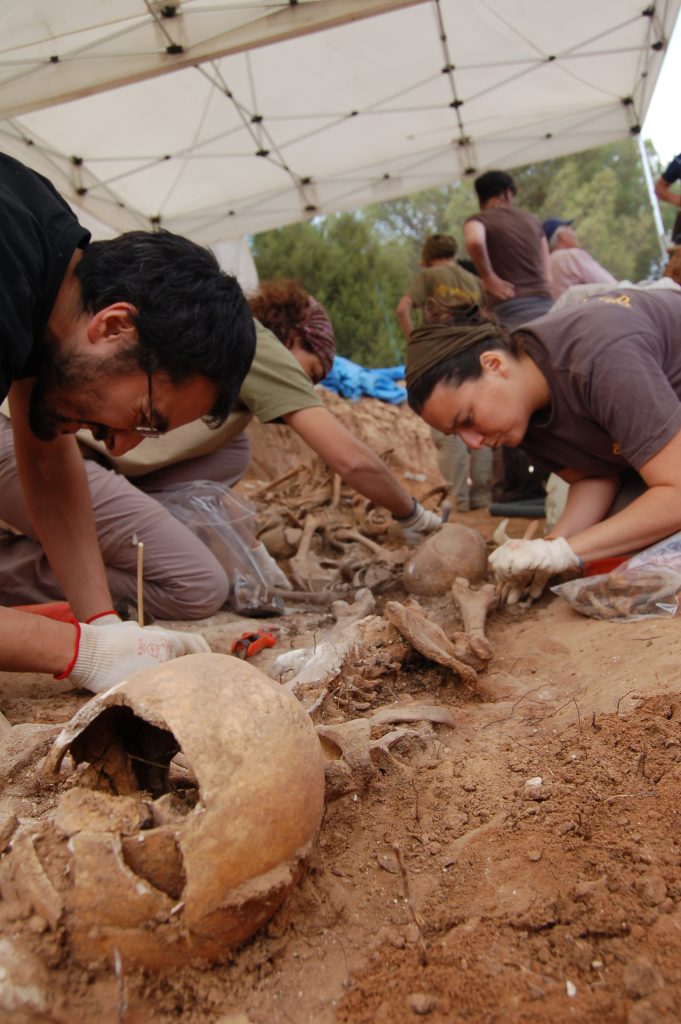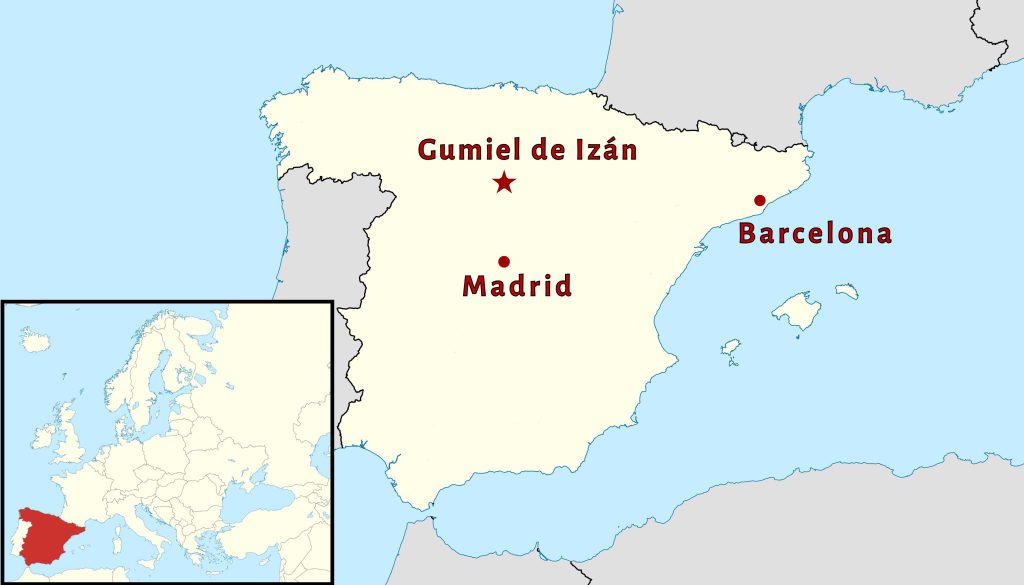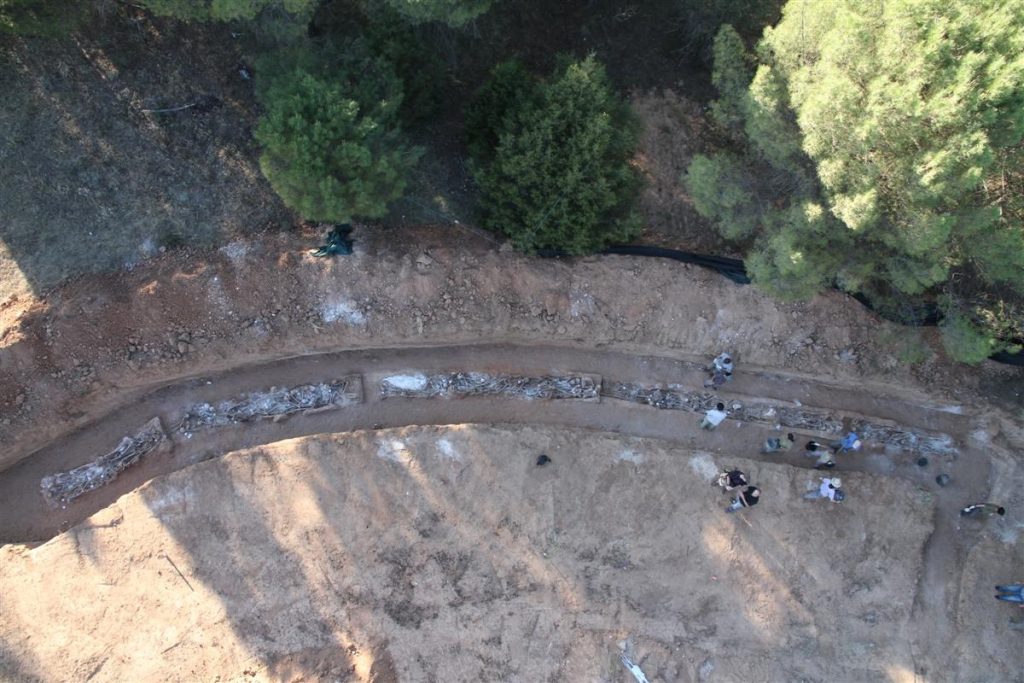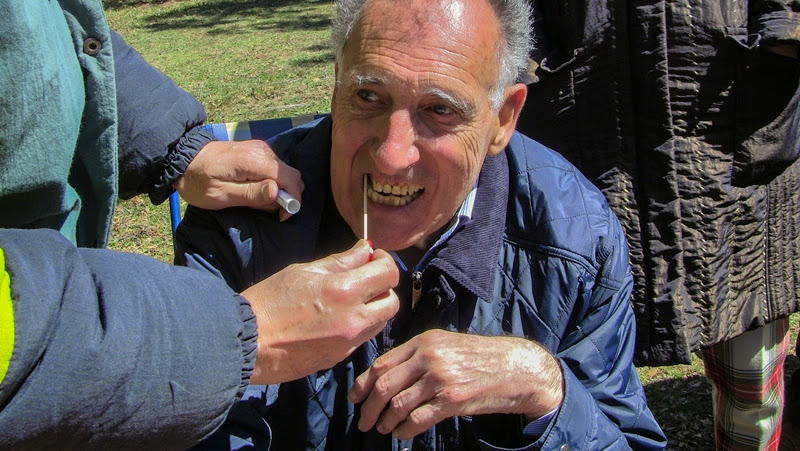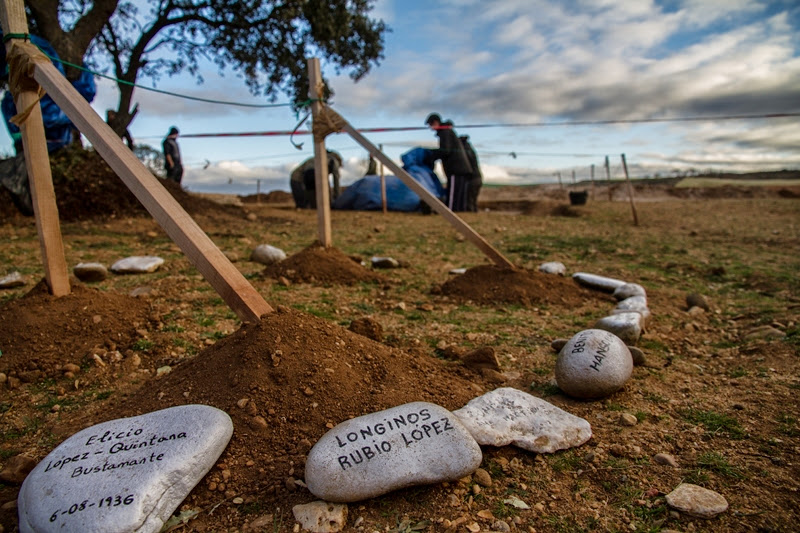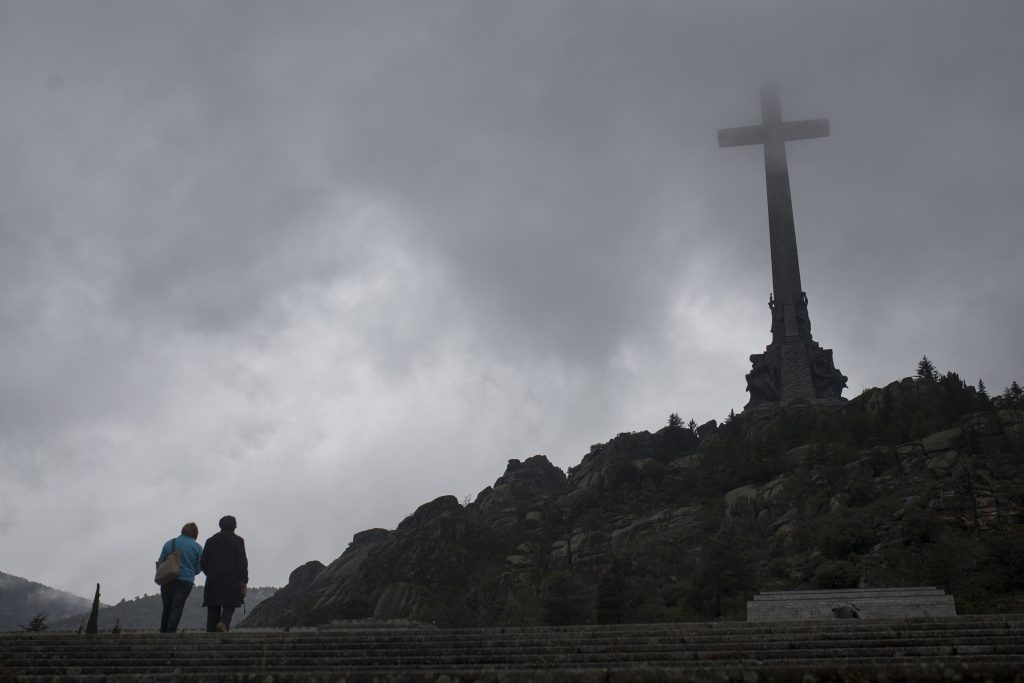Gathering the Genetic Testimony of Spain’s Civil War Dead
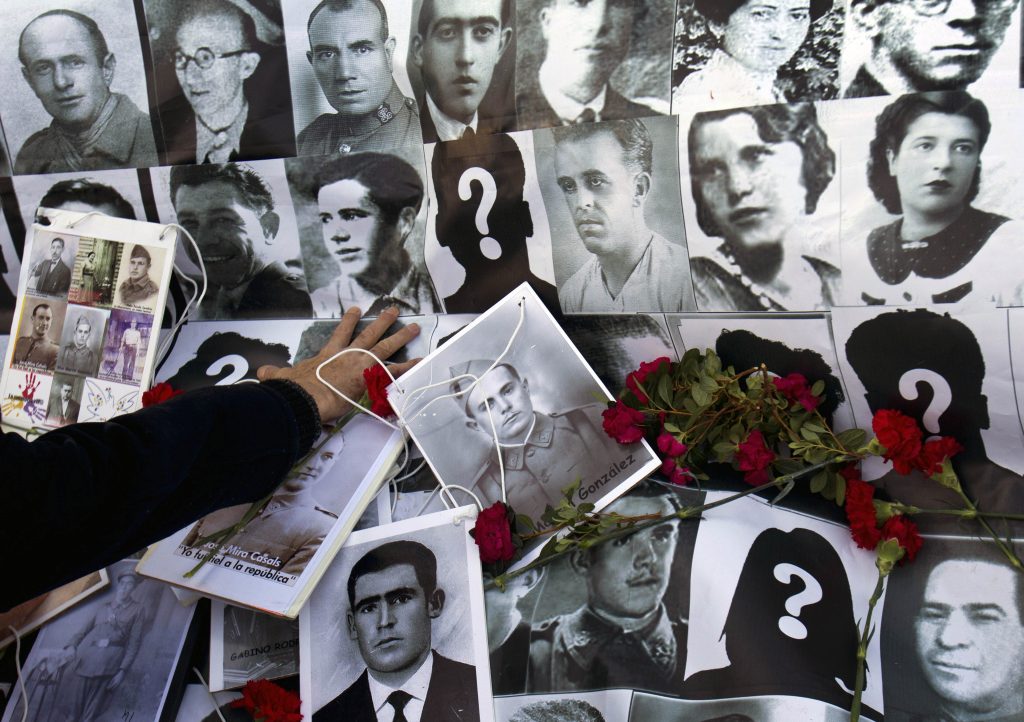
Please note that this article includes images of human remains.
In a waist-high trench alongside Spain’s national Highway 1, a dozen volunteers wearing rubber gloves brush tan clay from crumbling human bones. Their knees rest on foam cushions, and a white tent shades them from the summer sun. It’s July 2011—a full 75 summers after Spain erupted in the Civil War that put the bones of 59 civilians in the ground here.
A few steps away from the trench, volunteers hold microphones up to the murmuring mouths of elders from the town of Gumiel de Izán, in the north-central region of Castilla y León. The elders, who harbor memories of summary executions at the site, may well be the younger siblings, neighbors, and children of those in the grave. But at the moment of exhumation, nobody knows for sure. Instead, the volunteers document and collect the physical remains, coaxing out and recording imperfect memories that were suppressed during four decades of dictatorship.
Such sites are scattered throughout Spain, from the Canary Islands to La Mancha to the Balearic Islands. Recent estimates suggest that some 2,000 mass graves may hold the remains of up to 150,000 victims of hasty wartime executions.
Spaniards have searched for disappeared relatives and for answers about what happened to them since the Spanish Civil War ended in 1939. The war erupted in 1936 when a pro-Catholic, conservative faction rebelled against the secular, progressive elected government. All told, around 500,000 people died during the course of the three-year war. The dictatorship under Francisco Franco that ensued—which would last until the late 1970s—focused on using forensic investigation to identify and rebury its own war dead, often neglecting victims from the other side. The subsequent rise of forensic genetics in the 1980s, however, and a new political atmosphere in the 1990s and 2000s, have given Spaniards new tools with which to search for their missing relatives.
Social anthropologist Francisco Ferrándiz, of the Spanish National Research Council’s Institute of Language, Literature, and Anthropology in Madrid, was also present at the exhumation in Gumiel de Izán on that July day. His role there was to help record the fragile memories of the elders. He has also documented the rising use of forensic and genetic techniques by other researchers. Today Ferrándiz says that he and other such researchers share the sense that, “the social responsibility, the civic responsibility, was to get this information out into the public so that people would better understand.”
When a network of Spanish generals declared war against their government in July 1936, 20-year-old twin brothers Guillem and Ramón Malagarriga, weavers in a rural textile factory in l’Ametlla de Merola, thought about escape. In the first few months of the war, a so-called “hot terror” reigned. Rebels, called Nationalists, on one side, and Republicans, on the government side, were both killing thousands of civilians and burying them in shallow mass graves. As the coup matured into a war that would mobilize millions of soldiers, the Malagarriga brothers received a military draft notice from the government.
The Spanish Civil War was the culmination of decades of swings of the political compass, from monarchy to republic to dictatorship and back to republic. Of the estimated 500,000 lives lost in the war, roughly 150,000 were civilians killed by summary execution. Historians estimate that tens of thousands of the victims ended up in shallow graves by the sides of the roads where they were “taken out” or “gone for a stroll” (sacas and paseos in Spanish) by their killers, like the people whose remains were found near Gumiel de Izán. In other cases, authorities shot their prisoners in cemeteries, where victims fell straight into communal graves. In the midst of this, the Malagarriga brothers and two cousins chose to flee rather than fight.
Every Spanish family has a story like this one: a choice its loved ones made in 1936 to lay low, leave the country, or join the mayhem on one side, the other, or both.
In August 1937 the Malagarriga brothers found refuge from the military draft in their grandmother’s house in the countryside. Later they traversed the Pyrenean foothills toward Andorra. Guillem and his two cousins made it, but somewhere along the way authorities captured Ramón. In October 1937 Guillem returned to look for his brother and discovered that Ramón had been imprisoned for dodging the draft. According to family lore, Guillem turned himself in to avoid reprisals against his family for his own draft dodging. Records obtained by Ramón’s son, Marc Antoni Malagarriga, a software consultant in Manresa, reveal that authorities moved Guillem between prisons and a work camp. Guillem’s last sign of life is a postcard dated September 1938.
By late 1938 Nationalist forces had already cut Spain’s government-held territory in two. In April 1939 the Nationalists declared victory. Ramón, released from prison, went back to his home town. The remaining Malagarrigas certainly wondered where Guillem had ended up, but it was not a wise time to ask questions.
During the war, General Francisco Franco told United Press reporter James Miller that, “There will be no mediation because the delinquents and their victims cannot live side by side.” After the war ended, Franco, who by then had absolute power, made good on his threat. Those whom the Nationalists considered “delinquents” due to their past political or military activity lost many of the basic elements of citizenship. The state took their property, invalidated their professional qualifications, incarcerated many, and executed at least several tens of thousands of people over the following decade.
Despite crippling postwar poverty in the early 1940s, Spain’s new government began exhuming and reburying its own dead in church graveyards and family crypts. As any winning side does, the new Nationalist government wrote its history. It is inscribed in stone in graveyards around the country: “Fallen for God and Spain.”
There is also evidence of clandestine exhumations after the war, carried out by people who knew the locations of buried relatives who had not fallen for God or Nationalist Spain. Some exhumed and reburied the remains on their own terms. While clothing or basic forensic clues such as height sometimes made it possible to identify individuals, in many cases these groups of exhumed bones were reburied together. Relatives on both sides of the conflict often resigned themselves to ceding their loved ones’ remains to a communal plot.
The unofficial status of those wartime deaths continued to have repercussions even after the dictatorship ended with Franco’s death in 1975. Widows of the wartime disappeared could not, for example, collect a pension if they lacked a death certificate and the body of their husband. Many families conducted an initial, informal wave of exhumations in the late 1970s and early 1980s without the benefit of forensic support. At that time, “nobody expected a genetic identification,” Ferrándiz says, and the identification of remains was less precise, often mixing up the remains of people who died together.
Read more from the archives: “Black Lives Matter and Reflections From a Civil War.”
In 2000, Emilio Silva, then a journalist working on the television program Caiga Quien Caiga (roughly, “Heads May Roll”) in Madrid, began a campaign to identify the remains of his grandfather, who was summarily executed during the war. Silva recruited anthropologists, biologists, and other researchers. They investigated historical records and excavated a mass grave, finding 13 skeletons. In 2001, the team found a DNA match between Silva and some of the remains. It was the first DNA-aided identification of Spanish Civil War remains. Since then, court cases and hundreds of exhumations around the country have brought Spain’s war skeletons out of the closet and into the fierce public debate about how to reconcile the country’s violent history.
Despite new capabilities for probing the past, some Spaniards prefer not to look back. In March 2016, a prominent journalist on television asked acting president Mariano Rajoy, of the Popular Party, about the thousands of Spaniards who still did not know where their grandparents were buried. Rajoy answered, “It is not clear to me if what you say is true nor whether the government can do anything to fix it. What seems to me more common sense is that we try to avoid the repetition of such things in the future and not keep mulling over the past.”
Rajoy and others may fear that pursuits like Silva’s threaten to undermine the spirit of Spain’s 1977 amnesty law. The law was passed during the country’s transition from dictatorship to democracy. It forgave politically motivated criminal acts, both in favor of and against the dictatorship. It protected members of opposition parties that were illegal under the dictatorship, but it also enabled those who had established and worked for the dictatorship to participate in future governments. The spirit of this law is referred to as the Pacto del Olvido, or “the pact of forgetting.” So far, Spanish courts have defended the amnesty. But by recruiting researchers to apply the latest forensic techniques, cases like Silva’s appeal to forces that do not aid or abet forgetting: biology and international human-rights law.
Still, Silva’s case was unique. Apart from being the first to use DNA to identify remains from the Spanish Civil War, historical evidence linked his grandfather to a grave containing 13 bodies. That made it possible to compare his DNA to just 13 sets of remains and produce a likeliest match. But thanks to the fortuitous outcome and his strong media presence, many other relatives of the disappeared got in touch with Silva for help finding their own kin.
The issue reached a peak in 2007, when Spain’s Socialist government passed a law on “historical memory” that required the national government to facilitate and subsidize the identification of victims of Franco’s repression. The government spent a total of about 25 million euros supporting private groups that searched for the missing until 2011, when another party took power and cut off the funding.
Still, the ability to compare some DNA does not guarantee that a family will be able to identify its missing relatives. Today’s living relatives aren’t usually direct descendants, notes Marían M. de Pancorbo, a biologist at the University of the Basque Country in Álava. And the DNA collected from graves has often decayed in ways that complicate matches. Acids in humid soil can inhibit the reactions that researchers use to amplify DNA samples for identification. DNA molecules are long, complicated, and unwieldy, and they require constant upkeep in living things. But the fields of paleontology and anthropology have collaborated to develop improved techniques for collecting tiny samples of DNA from Neanderthals and other early humans, along with big mammals, found in caves around the world. Only in the last decade or two have researchers found ways to extract DNA from ancient bones, degraded by thousands of years of exposure to water, soil, and microbial action, and amplify enough of it to make meaningful inferences. Those same techniques apply to the decades-old bones from Spain’s Civil War.
De Pancorbo’s group had been working on prehistoric DNA, unrelated to modern wars, when forensic anthropologist Francisco Etxeberria, of the University of the Basque Country in San Sebastián, approached her research group for help identifying remains from the Civil War. Etxeberria has emerged as a key player among those studying Civil War exhumations. Last year Etxeberria and de Pancorbo co-authored a review of their genetic analyses of the remains of 252 individuals from the preceding five years. The team reported that they were able to quantify DNA in about two-thirds of the cases, mostly using entire teeth or samples obtained from long bones such as legs. They have also gathered DNA from 186 living relatives and compared genetic markers of several types. One of their important innovations has been establishing markers in nuclear DNA, which is available thanks to improved extraction techniques, and which now enables them to tie the DNA of exhumed remains to descendants of both genders.
Marc Antoni Malagarriga, the software consultant, has made it his mission to help researchers connect such forensic evidence with the DNA of living relatives. In 2011, he asked forensic geneticist Carme Barrot at the University of Barcelona if she would store his own DNA, in hopes of someday identifying the remains of his uncle. While the university did take his DNA sample, and has begun to take those of others as well, exhumations are the responsibility of a Catalan regional government committee for mass graves. Between the committee and efforts that predate it, only 21 of the estimated 230 mass graves in its jurisdiction (other estimates range close to 350) have been excavated. The Catalan regional government has received at least 4,774 requests for help finding relatives lost in the Civil War; it claims to have identified the graves of 527 victims.
Malagarriga never met his uncle Guillem. Yet he and others began a campaign to establish protocols for collecting samples from exhumed remains, for storing collected DNA in a bank, and for publicizing the bank’s existence. They sent proposals to the Catalan regional parliament and provided evidence to a United Nations delegation, which visited Spain in September 2013 to investigate forced disappearances and the present-day government’s response. “On the one hand, you do it for the people who spoke to you about [Guillem],” he says, such as his deceased father and aunts, “and then I do it because our governments have to do the humanitarian work as God intended.”
The UN delegation noted that seeking the truth about what happened to the disappeared is an obligation for states that have signed a 1992 declaration on forced disappearances, which Spain did in 2007. The delegation also pointed to the absence of a central genetic database in Spain for identifying the disappeared.
“I think the most useful thing would be an official bank where we all put our data,” Barrot says. That way all participants could agree on common identification and ethics standards and the bank would contain a larger pool of missing and searching relatives. This is already occurring in Vietnam, Poland, Argentina, Guatemala, and other sites of mass forced disappearances. But in Spain, the hodgepodge of laboratories capable of building such a database operate only on a local level. They lack the ability to systematically share data with one another. Large-scale cross-checking of fuller genetic profiles would require expensive criminal-investigation tools that the Spanish state has not shared with university or other Civil War grave researchers, Ferrándiz says.
Instead, activism continues from the bottom up, without the support or subsidies mandated in the 2007 historical-memory law. In Catalonia, Barrot and Malagarriga have been publicizing their growing DNA bank, but so far have heard from only around 140 of the 4,800 families with missing relatives registered with the Catalan regional government. Malagarriga is one of the few who have paid the 150 euros (US$170) it costs to provide the relevant DNA sample. Even if children of the war dead, now at least in their late 70s, do leave genetic samples, few will ever see the bones of their lost ancestors. That generation is still not over the war, Barrot says: “Some of the children are still scared to talk about it, they’ve been repressed so long. That’s what impresses me. We’ve had [40] years of democracy.”
Malagarriga says that in addition to the usual institutional inertia, many officials are uninterested in or resistant to cooperating with Civil War investigations. “Memory is bound on all sides by amnesty,” he says.
Spain is also bound on all sides by physical, undeniable markers of its memories. Some 60 kilometers northwest of Madrid, a dark green mountain range snakes north. Hikers can walk along the remnants of trenches and embattlements built during the Civil War from peak to peak along the mountain chain. Today, looking from this mountain ridge toward Madrid, visitors can see a 150-meter stone cross perched atop a natural rocky outcrop.
The cross and surrounding complex, called the Valle de los Caídos (Valley of the Fallen), comprise Spain’s largest memorial and resting place for Civil War dead. At the end of the war, Franco ordered the site’s construction to commemorate the dead from both sides. Its basilica is on a scale comparable to St. Peter’s in Rome. The ground underneath it holds between 33,700 and 50,000 war dead, exhumed and reburied, many before being identified. It is one of Spain’s most-visited tourist sites, and every year activists visit to pay tribute to Franco, who is buried there. Still other activists visit to protest. Critics argue that the site is a symbol of the heavy-handedness of the dictatorship, which never consulted the families of war dead from the losing side buried there. It is part of the ongoing dispute over how Spain should have handled the bodies and the reputations of those who died in the war and their survivors.
The state’s hands-off policy since then has slowed down identifications and made it unlikely that researchers will link many more living relatives with the roughly 8,500 Civil War victims they have found so far in 400 scientific exhumations performed since the year 2000.
Malagarriga may never find his uncle, but the search has given him a way to relate to his father and aunts, who used to tell stories about his missing uncle. It has also helped to create a genetic database that may aid others in finding their own families. Genetic evidence is easier than ever to gather. And perhaps with international pressure, some who wish to identify their missing dead will be able to, despite the state. In his writing, Ferrándiz calls this “biological, transnational citizenship.” Biology may offer ways to restore family stories torn asunder by the collapse of the state. It may help bypass decades of mediation and neglect. But the nearest relatives of Spain’s Civil War dead are running out of time, and many will not live long enough to see it come to pass.
The tangle of bones unearthed in Gumiel de Izán in 2011 now sits in a common pantheon in nearby Aranda de Duero. The public money for identifying the remains dried up in 2012, so they will sit there until more financial support appears, says Ferrándiz. Some has come from outside: In 2015, Silva and the Association for the Recovery of Historical Memory (which Silva co-founded) won a $100,000 prize from the U.S.-based Abraham Lincoln Brigade Archives and the Puffin Foundation. And some funds have emerged in regional governments: The Catalan government has budgeted some $113,000 for exhumations in 2016. Spain faces new elections this month, and some political parties have promised to restore funding to the search for the disappeared.
But there is little certainty, and less time, for the living descendants of Spain’s disappeared. “That’s been sad to me as a citizen,” Ferrándiz says. “As a researcher, it’s just one more datum, but it’s sad as a citizen.”
This article was republished on scientificamerican.com. Véalo en Español aquí.































